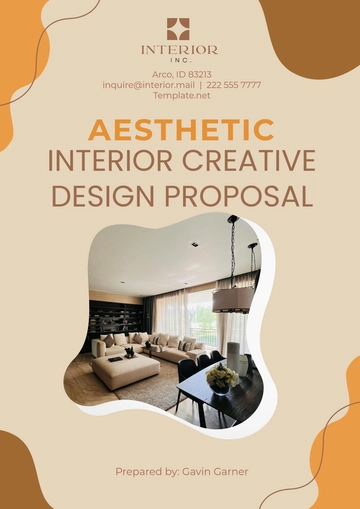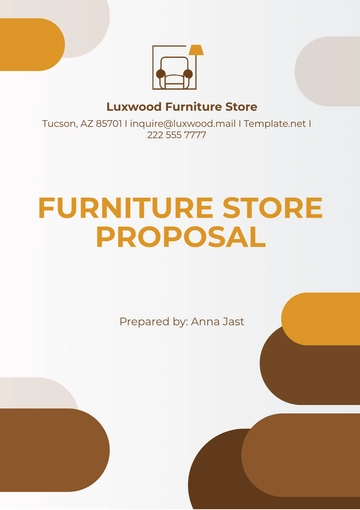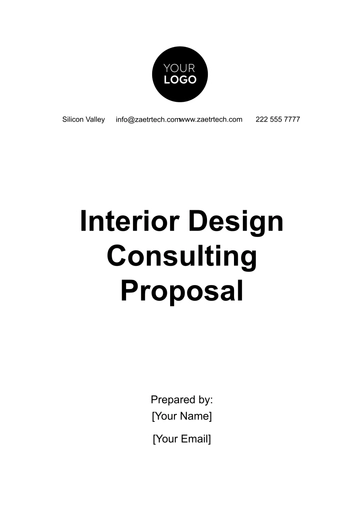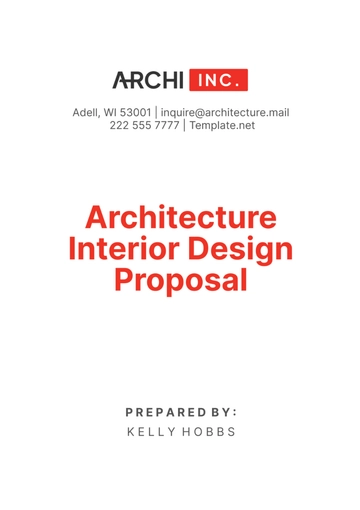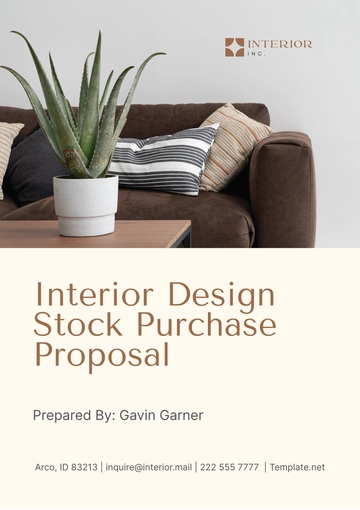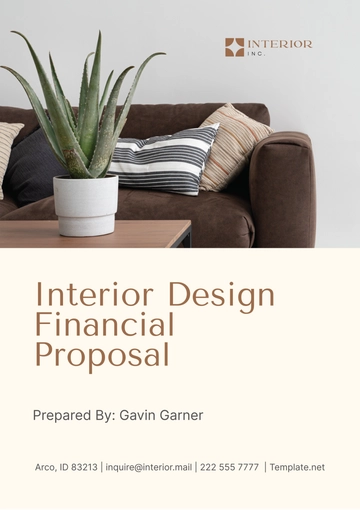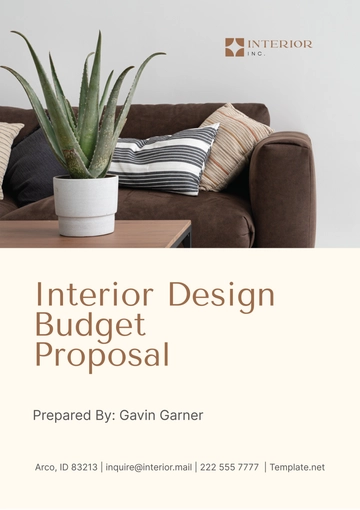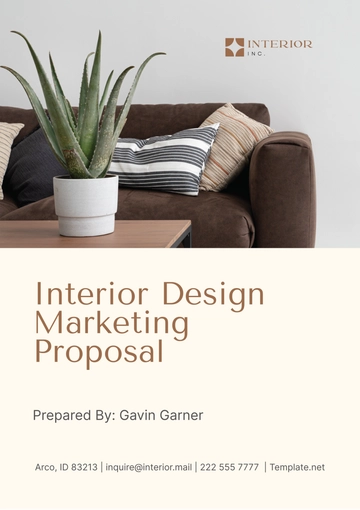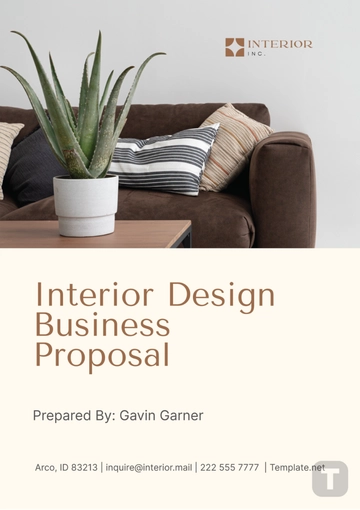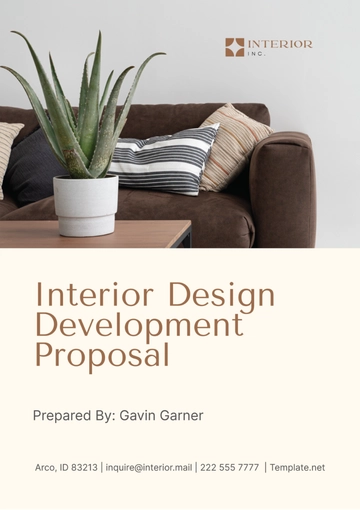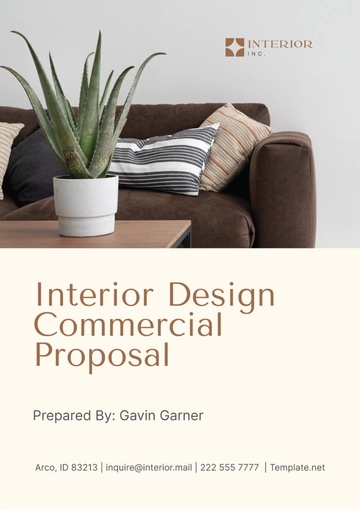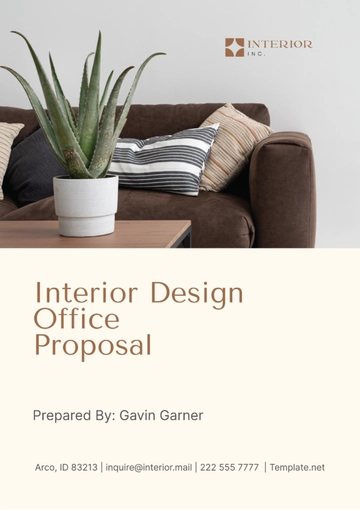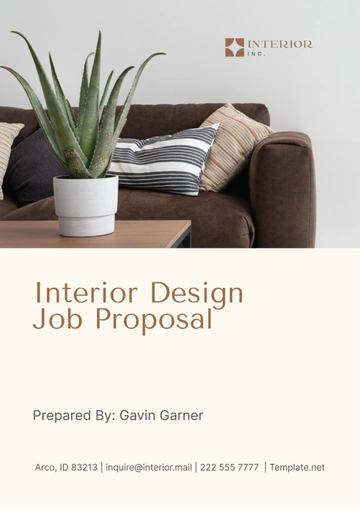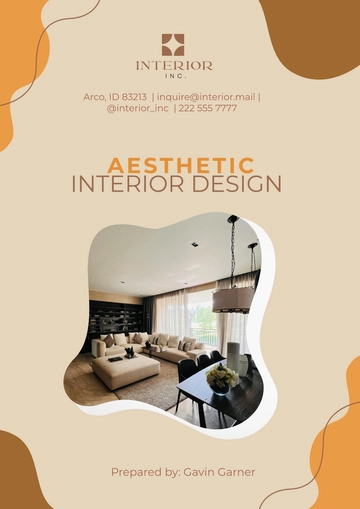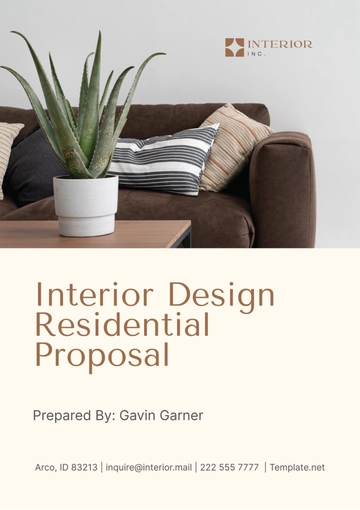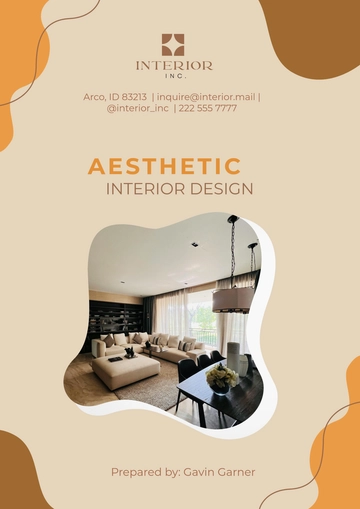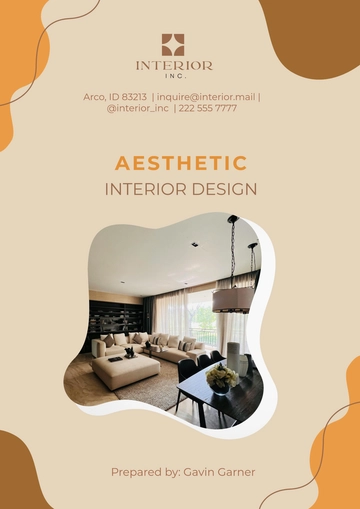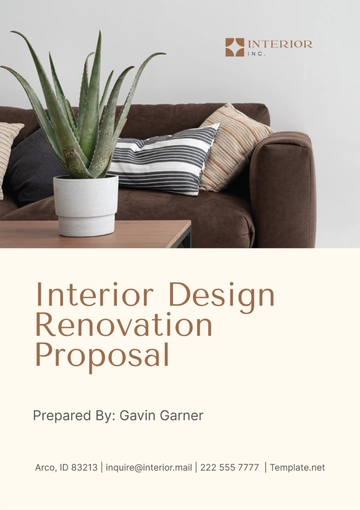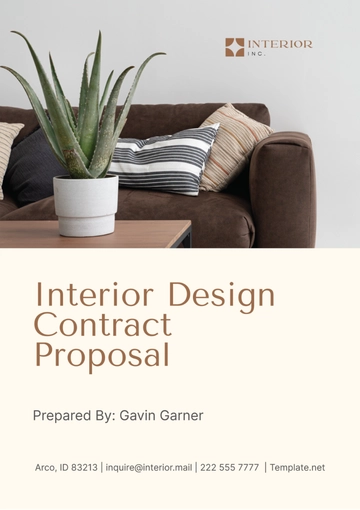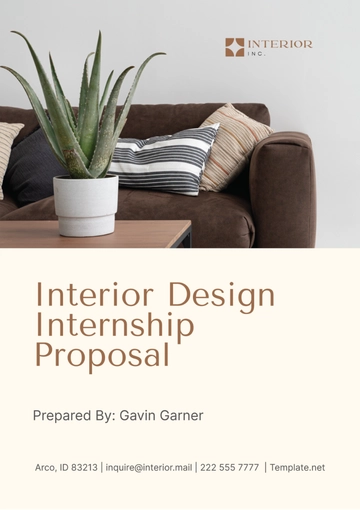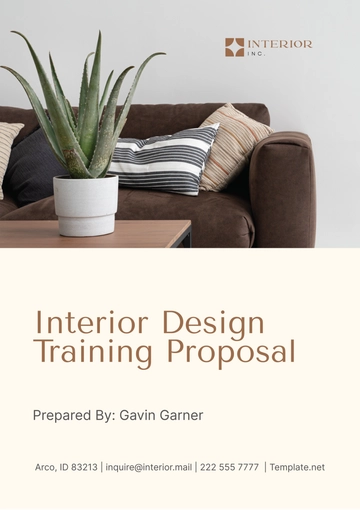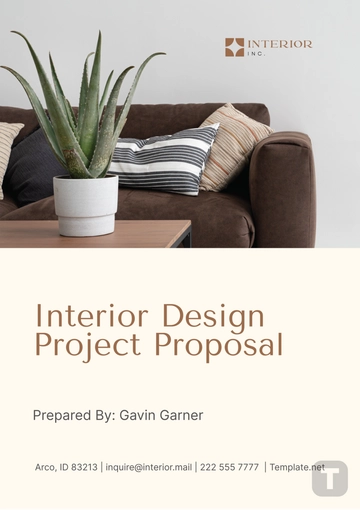Free Interior Design Marketing Proposal
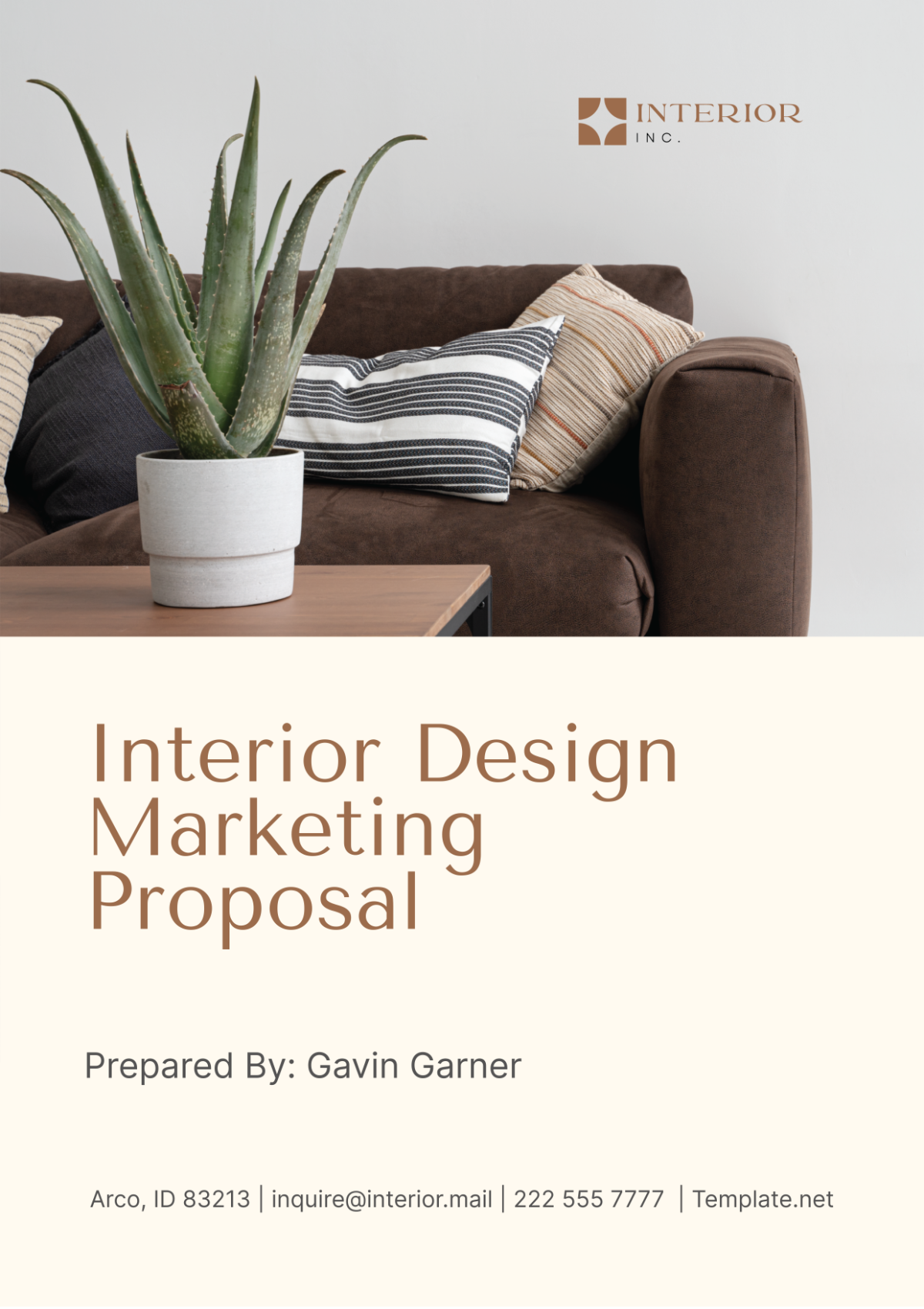
I. Executive Summary
A. Overview
[Your Company Name], a reputable marketing agency specializing in the [industry], presents this Interior Design Marketing Proposal to [Client's Company Name]. Our proposal aims to elevate your brand's presence in the competitive interior design market through strategic marketing initiatives. By leveraging our expertise and innovative approaches, we intend to position [Client's Company Name] as a trusted authority in the industry while driving significant growth and attracting new clients. With a focus on creativity, professionalism, and client satisfaction, we are committed to delivering measurable results and exceeding your expectations.
B. Objectives
Our proposed objectives for this marketing campaign are as follows:
Objectives | Details |
|---|---|
Increase brand awareness and recognition | Enhance visibility through targeted advertising and content strategies |
Generate qualified leads and inquiries | Drive engagement and conversions through compelling marketing content |
Showcase expertise and portfolio | Highlight unique design projects and client success stories |
Establish thought leadership | Publish insightful content and participate in industry events |
Increase website traffic and social media engagement | Optimize online presence to attract and retain a wider audience |
C. Scope of Work
To achieve the outlined objectives, our scope of work includes:
Market Research and Analysis: Comprehensive research to identify market trends, competitor strategies, and target audience preferences.
Marketing Strategy Development: Customized strategy development tailored to [Client's Company Name]'s goals and budget constraints.
Content Creation: Creation of engaging and informative content, including blog posts, social media updates, infographics, and videos.
SEO Optimization: Implementation of search engine optimization (SEO) techniques to improve website visibility and organic traffic.
Social Media Management: Management of social media platforms (e.g., Instagram, Pinterest, Houzz) to build a strong online presence and engage with the target audience.
Advertising Campaigns: Creation and management of online advertising campaigns across various platforms (e.g., Google Ads, Facebook Ads) to reach new audiences and drive conversions.
Performance Monitoring and Reporting: Regular monitoring of key performance indicators (KPIs) such as website traffic, engagement metrics, and lead generation. Provision of detailed reports to track campaign effectiveness and make data-driven decisions.
D. Timeline
We propose a timeline of [Jan 2050 - June 2050] for the completion of this project, with key milestones including strategy development, content creation, and campaign implementation. A detailed timeline will be provided upon agreement.
E. Investment
The proposed investment for this comprehensive interior design marketing campaign is [$90,000]. This includes all strategy development, content creation, advertising expenses, and ongoing management. Our pricing is competitive and reflects the value and expertise we bring to the table.
II. Market Analysis
A. Industry Overview
The interior design industry is experiencing robust growth, fueled by increasing demand for personalized and aesthetically pleasing spaces. According to market research, the global interior design market is valued at approximately [$12 billion] and is expected to grow at a CAGR of [35%] over the next [10 years]. Key factors driving this growth include:
Rising Disposable Income: Increasing disposable income levels among consumers, particularly in emerging economies, are driving higher spending on home décor and interior design services.
Urbanization Trends: Rapid urbanization and population growth in urban centers are leading to higher demand for residential and commercial interior design solutions.
Shift towards Sustainable Design: Growing environmental awareness has led to a surge in demand for sustainable and eco-friendly design solutions, driving innovation in materials and construction techniques.
Technological Advancements: Advancements in technology, such as virtual reality (VR) and augmented reality (AR), are revolutionizing the interior design process, allowing designers to create immersive experiences and visualize projects in real-time.
B. Target Audience Analysis
Understanding the target audience is crucial for effective marketing. The primary target audience for [Client's Company Name] includes:
Demographics: Affluent homeowners, real estate developers, architects, and business owners seeking premium interior design services.
Psychographics: Individuals who value creativity, innovation, and quality craftsmanship in interior design. They prioritize aesthetics, functionality, and sustainability in their design choices.
Behavior: Decision-makers who research extensively online before engaging with design professionals. They are active on social media platforms and rely on online reviews and recommendations to inform their purchasing decisions.
Needs and Pain Points: The target audience desires unique and personalized design solutions that reflect their individual style and preferences. They are concerned about budget constraints, project timelines, and the need for reliable and trustworthy designers who can deliver exceptional results.
III. Marketing Strategy
A. Brand Positioning
Define Unique Value Proposition: Conduct in-depth interviews and surveys with key stakeholders to identify [Client's Company Name]'s unique strengths, such as innovative design concepts, personalized approach, or exceptional customer service.
Identify Key Differentiators: Analyze competitor strategies and market trends to pinpoint areas where [Client's Company Name] can differentiate itself, whether through specialization in a particular design style, use of sustainable materials, or expertise in specific sectors (e.g., residential, commercial, hospitality).
Position as Premium Service Provider: Develop messaging and branding strategies that emphasize [Client's Company Name]'s commitment to quality, craftsmanship, and attention to detail, positioning the brand as a premium choice for discerning clients.
B. Content Strategy
Develop Content Calendar: Collaborate with [Client's Company Name] to develop a content calendar outlining topics, formats, and distribution channels, ensuring alignment with brand messaging and marketing objectives.
Create Engaging Content: Leverage a mix of formats, including blog posts, articles, case studies, and visual content (e.g., photos, videos, infographics), to showcase [Client's Company Name]'s portfolio, share design insights, and provide valuable tips and inspiration to the target audience.
Tailor Content for Each Channel: Customize content for different platforms and audience segments, optimizing it for search engines and social media platforms to maximize visibility and engagement.
Implement Email Marketing Campaigns: Develop targeted email campaigns to nurture leads, promote upcoming events or promotions, and maintain ongoing communication with past and potential clients.
C. Online Presence Optimization
Conduct Keyword Research: Identify relevant keywords and search terms related to interior design services, target audience preferences, and industry trends to inform content creation and SEO optimization efforts.
Optimize Website Content: Update website content, meta tags, and image alt text to improve search engine visibility and user experience, ensuring that [Client's Company Name]'s website ranks prominently in relevant search results.
Develop Link-Building Strategy: Build high-quality backlinks from reputable websites and directories within the interior design industry to improve domain authority and credibility, boosting [Client's Company Name]'s visibility and search engine rankings.
Enhance User Experience: Optimize website design and navigation to enhance user experience and reduce bounce rates, ensuring that visitors can easily find information about [Client's Company Name]'s services, portfolio, and contact details.
D. Social Media Management
Establish Strong Social Media Presence: Create and optimize profiles on key social media platforms, including Instagram, Pinterest, Houzz, and LinkedIn, to showcase [Client's Company Name]'s portfolio, engage with followers, and build brand awareness.
Curate Compelling Content: Share visually appealing photos and videos of completed projects, behind-the-scenes glimpses of the design process, client testimonials, and relevant industry news to keep followers engaged and encourage sharing and interaction.
Engage with Audience: Respond promptly to comments, messages, and inquiries from followers, fostering meaningful conversations and building relationships with potential clients and industry influencers.
Run Targeted Advertising Campaigns: Utilize social media advertising tools to create targeted campaigns aimed at reaching specific demographics, geographic locations, or interests, driving traffic to [Client's Company Name]'s website and generating leads.
IV. Implementation Plan
A. Strategy Development
Initial Consultations: Conduct in-depth consultations with [Client's Company Name] to understand their goals, target audience, brand identity, and competitive landscape, gathering insights to inform the development of a customized marketing strategy.
Market Research and Analysis: Conduct comprehensive market research and competitor analysis to identify industry trends, emerging opportunities, and areas for differentiation, providing a solid foundation for strategic decision-making.
Strategy Development: Collaborate with [Client's Company Name] to develop a tailored marketing strategy encompassing brand positioning, content creation, SEO optimization, social media management, and advertising campaigns, outlining clear objectives, tactics, and timelines for implementation.
B. Content Creation
Resource Allocation: Allocate resources, including writers, designers, photographers, and videographers, to support content creation efforts, ensuring high-quality, visually compelling content that aligns with [Client's Company Name]'s brand identity and messaging.
Content Calendar Development: Develop a content calendar and production schedule outlining topics, formats, deadlines, and distribution channels, facilitating efficient content creation and coordination among team members.
Content Creation: Produce a diverse range of content, including blog posts, articles, case studies, videos, and social media updates, highlighting [Client's Company Name]'s expertise, portfolio, and unique design approach, and addressing the needs and interests of the target audience.
C. Campaign Implementation
Campaign Launch: Execute marketing campaigns across various channels, including website, social media, email, and online advertising, following the strategic plan outlined in the marketing strategy, and adhering to predefined timelines and budgets.
Monitoring and Optimization: Monitor campaign performance and key performance indicators (KPIs), such as website traffic, engagement metrics, lead generation, and conversion rates, using analytics tools to track progress and identify areas for optimization.
Continuous Improvement: Continuously evaluate campaign performance, test new strategies and tactics, and iterate based on insights and feedback, ensuring that [Client's Company Name]'s marketing efforts remain effective and aligned with business objectives.
V. Measurement and Reporting
A. Key Performance Indicators (KPIs)
KPIs | Details |
|---|---|
Website Traffic | Monthly unique visitors, page views, bounce rate |
Social Media Engagement | Likes, shares, comments, followers |
Lead Generation | Number of inquiries, form submissions, conversion rate |
Brand Sentiment | Positive/negative sentiment analysis |
Return on Investment (ROI) | Cost per lead, cost per acquisition, revenue generated |
B. Reporting Frequency
[Your Company Name] will provide monthly reports detailing campaign performance, key metrics, and recommendations for optimization. Reports will include:
Executive Summary: Overview of key findings and insights from the reporting period.
Performance Metrics: Detailed analysis of KPIs, including website traffic, social media engagement, lead generation, and ROI.
Campaign Performance: Evaluation of the effectiveness of marketing campaigns and initiatives, highlighting successes and areas for improvement.
Competitor Analysis: Comparison of [Client's Company Name]'s performance against competitors, identifying strengths, weaknesses, and opportunities.
Recommendations: Actionable recommendations for optimizing future marketing efforts, based on data-driven insights and industry best practices.
VI. Conclusion
[Your Company Name] is committed to helping [Client's Company Name] achieve its marketing objectives and drive business growth through innovative and effective strategies. We are confident that our tailored approach to interior design marketing will deliver tangible results and exceed your expectations.
We look forward to the opportunity to partner with [Client's Company Name] and contribute to the success of your interior design business. Please don't hesitate to reach out with any questions or to discuss the proposal further.
- 100% Customizable, free editor
- Access 1 Million+ Templates, photo’s & graphics
- Download or share as a template
- Click and replace photos, graphics, text, backgrounds
- Resize, crop, AI write & more
- Access advanced editor
Attract clients confidently with Template.net's Interior Design Marketing Proposal Template. This customizable document provides a professional and persuasive format for presenting interior design services to potential clients. Showcase your expertise, portfolio, and value proposition to win new projects. Editable in our Ai Editor Tool for seamless customization to highlight your unique selling points and creative solutions.
You may also like
- Business Proposal
- Research Proposal
- Proposal Request
- Project Proposal
- Grant Proposal
- Photography Proposal
- Job Proposal
- Budget Proposal
- Marketing Proposal
- Branding Proposal
- Advertising Proposal
- Sales Proposal
- Startup Proposal
- Event Proposal
- Creative Proposal
- Restaurant Proposal
- Blank Proposal
- One Page Proposal
- Proposal Report
- IT Proposal
- Non Profit Proposal
- Training Proposal
- Construction Proposal
- School Proposal
- Cleaning Proposal
- Contract Proposal
- HR Proposal
- Travel Agency Proposal
- Small Business Proposal
- Investment Proposal
- Bid Proposal
- Retail Business Proposal
- Sponsorship Proposal
- Academic Proposal
- Partnership Proposal
- Work Proposal
- Agency Proposal
- University Proposal
- Accounting Proposal
- Real Estate Proposal
- Hotel Proposal
- Product Proposal
- Advertising Agency Proposal
- Development Proposal
- Loan Proposal
- Website Proposal
- Nursing Home Proposal
- Financial Proposal
- Salon Proposal
- Freelancer Proposal
- Funding Proposal
- Work from Home Proposal
- Company Proposal
- Consulting Proposal
- Educational Proposal
- Construction Bid Proposal
- Interior Design Proposal
- New Product Proposal
- Sports Proposal
- Corporate Proposal
- Food Proposal
- Property Proposal
- Maintenance Proposal
- Purchase Proposal
- Rental Proposal
- Recruitment Proposal
- Social Media Proposal
- Travel Proposal
- Trip Proposal
- Software Proposal
- Conference Proposal
- Graphic Design Proposal
- Law Firm Proposal
- Medical Proposal
- Music Proposal
- Pricing Proposal
- SEO Proposal
- Strategy Proposal
- Technical Proposal
- Coaching Proposal
- Ecommerce Proposal
- Fundraising Proposal
- Landscaping Proposal
- Charity Proposal
- Contractor Proposal
- Exhibition Proposal
- Art Proposal
- Mobile Proposal
- Equipment Proposal
- Student Proposal
- Engineering Proposal
- Business Proposal
